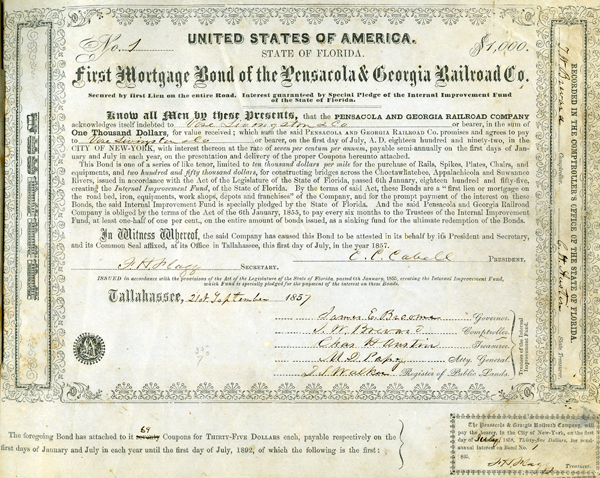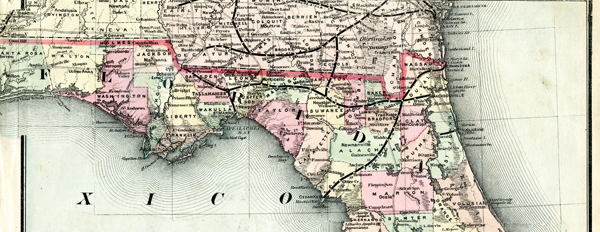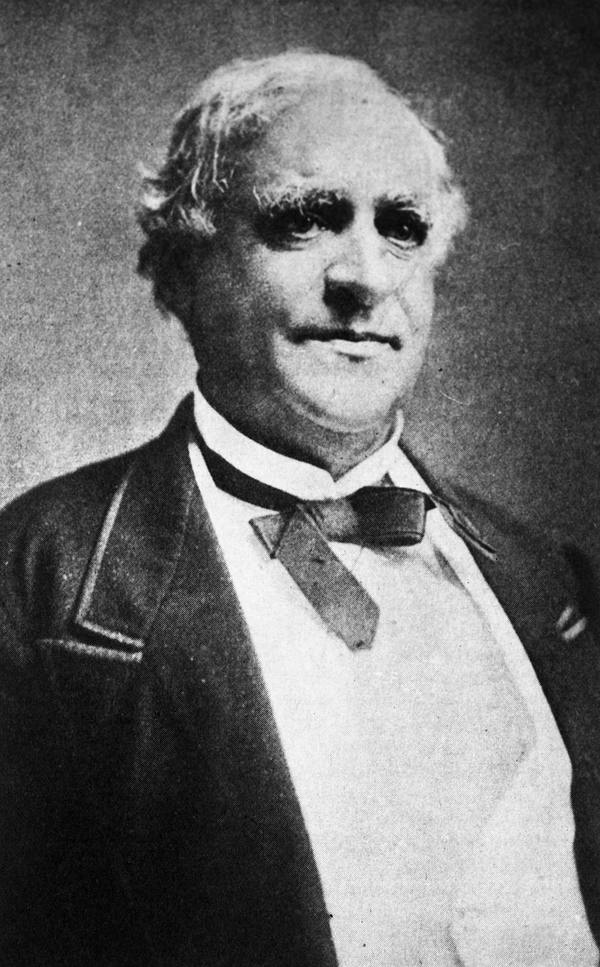Description of previous item
Description of next item
Florida Railroads and the Civil War
Published June 6, 2013 by Florida Memory
Railroads played a decisive role in the Civil War. The ability to rapidly move troops and supplies on a vast scale greatly increased the war making potential of both sides. When the war began, two thirds of U.S. railroads were in the North, which could draw on its tremendous industrial base to repair, replenish and construct rail lines, cars and locomotives. The South had to conserve and utilize its limited railroad resources to the best possible effect. Paradoxically, for a nation built on the premise of limited government and state's rights, the Confederacy, if it was to survive, had to subordinate the rights of private railroads to benefit the national war effort. One of the clearest examples of this conflict of interest occurred in Florida in the summer of 1863, when Governor John Milton sought to obtain rails from the Florida Railroad owned by former United States senator David Levy Yulee.
With 402 miles of track in 1860, Florida had the lowest track mileage in the South, which by the beginning of the war had a total of 9,000 miles compared to 21,000 miles in the North. In 1861, only two interstate lines between Florida and Alabama linked Florida to another state. In 1861, there was no rail link between Florida and Georgia, and there was no railroad between Pensacola and the rest of the state. The Pensacola & Georgia Railroad and the Atlantic & Gulf Central Railroad companies were chartered to build a railroad from Jacksonville to Pensacola, but by 1861 the road only ran between Jacksonville and Tallahassee, just half of the planned route. In 1862, the route reached Quincy, 20 miles to the west of Tallahassee, but no further.
In October 1861, when John Milton became governor of Florida, the Pensacola & Georgia Railroad and the Atlantic & Gulf Railroad, a Georgia railroad, were engaged in a joint project to link their roads at the Florida-Georgia border 22 miles north of Live Oak, Florida and 35 miles south of Lawton, Georgia (now Du Pont, Georgia); however, only the Georgia company had enough iron rails to complete its portion of the route. The Pensacola & Georgia appealed to the Confederate government for funds to procure the needed rails. Jefferson Davis and the Confederate War Department recognized the utility of the proposed route. Florida relied on troops from Georgia to help defend itself, and Florida agriculture was an important source of Confederate supplies. A rail link between Georgia and Florida would allow the swift movement of Georgia troops into the state and Florida foodstuffs into the rest of the Confederacy. Florida, however, was not a strategic priority for the Confederacy. The Confederate Congress refused to support the Pensacola & Georgia's request for funds for rails.

Bond No. 1, Pensacola & Georgia Railroad Company, 1857. State Archives of Florida, Florida Comptroller's Office Railroad Bonds, Series S660.
The Pensacola & Georgia then turned to Governor Milton for help. Even though his first priority was to see the Pensacola & Georgia's road extended from Quincy to Chattahoochee on the Apalachicola River, which he believed was the most likely route of a Union invasion, he readily agreed to use his influence to try and secure the rails needed to finish the Live Oak to Lawton route. He believed the rails could be removed from the Florida Railroad, which ran from Fernandina on the Atlantic to Cedar Key on the Gulf of Mexico. As the Union captured Fernandina and Cedar Key in 1862, the railroad no longer connected Florida's Atlantic and Gulf coasts. Therefore, its remaining track, Milton argued, possessed little military value. In May 1863, he began a campaign to get David Levy Yulee, the father and principal stockholder of the Florida Railroad, to turn over rails to the Pensacola & Georgia to complete the Live Oak to Lawton connection.
Besides his belief that the Florida Railroad was no longer of military value, Milton told Yulee that it was his patriotic duty to relinquish the rails for the sake of the Confederate war effort. Yulee responded with a legal argument. He wrote Milton that according to the law governing Florida's Internal Improvement Trust Fund, which sold state lands to enable the construction of railroads, the Florida Railroad Company, which had been entrusted with a resource (the railroad) vital to the public interest, could not endorse its own destruction. In reply, Milton informed Yulee that the Board of Trustees of the Internal Improvement Trust Fund, on which Milton served, voted to allow the state to sell or loan the Florida Railroad's iron rails to the Confederate government. The Milton-Yulee fight for the Florida Railroad was underway.
The Confederate government agreed with Milton's position and entered the campaign against Yulee's railroad which lasted into the summer of 1864. When it became clear that Yulee was not going to turn over the rails, the Confederate War Department ordered the Confederate Army to remove the rails by force. This order was based on the authority of the Impressment Act, which gave the Confederate government the right to "impress" supplies vital for the war effort. Although the Army was required to pay compensation for its impressments, the payments were much below market price and transacted using increasingly worthless Confederate currency. In the summer of 1864, the Confederate District Court for the Eastern District of Florida overruled a state court's injunction to halt the Confederate Army's confiscation of the Florida Railroad's rails. The Confederate Army took the rails and gave them to the Pensacola & Georgia for the completion of the Live Oak to Lawton connection. However, by the time the connection opened in March 1865 the war was almost over.
Cite This Article
Chicago Manual of Style
(17th Edition)Florida Memory. "Florida Railroads and the Civil War." Floridiana, 2013. https://www.floridamemory.com/items/show/259738.
MLA
(9th Edition)Florida Memory. "Florida Railroads and the Civil War." Floridiana, 2013, https://www.floridamemory.com/items/show/259738. Accessed December 15, 2025.
APA
(7th Edition)Florida Memory. (2013, June 6). Florida Railroads and the Civil War. Floridiana. Retrieved from https://www.floridamemory.com/items/show/259738

 Listen: The Latin Program
Listen: The Latin Program
